Amid extensive protest, Iran is set to conduct a Parliamentary election on Friday (March 1st). There will be two separate polls, one for members of Parliament and the other one for the 88 members of the Assembly of Experts, who are responsible for appointing, dismissing, and overseeing Iran’s most powerful figure, the Supreme Leader.
Elections in Iran 
Voters
In Iran, roughly 61.2 million people are eligible for voting, and they are above 18 years of age, of a total population of 87 million. The poll across the country will open at 8 am local time and be open for 10 hours.
Voting and Security Measures
There will be 59,000 operational voting stations across the country, 5000 in Tehran, and 6800 in the wider province of Tehran. Electronic voting devices will be available for use at 1700 stations.
For security, 250,000 security force personnel are deployed by the Interior Ministry. Islamic Revolutionary Guard Crops (IRGC), its Baslj forces, and the army will also be deployed, amidst recent events (protests) for security.
Voters Turnout
During the 2021 Presidential election, voter turnout was 49 percent, marking the lowest recorded turnout for a Presidential poll. Ebrahim Raisi had won the election. Similarly, In the 2019 Presidential election, the turnout stood at 42 percent.
Factors Influencing Turnout 
There are several factors responsible for lower vote turnout including the 2017 and 2019 protests, in 2020 US assassination of IRGC Quds Force commander Qassem Soleimani, the inception of the Covid-19 pandemic, and the downing of a Ukrainian passenger flight. Further, economic challenges including high inflation rate, unemployment, and devaluing the country’s currency also played a crucial role.
Expected Winners
Parliament speaker Mohammad Bagher Ghalib, who is advocating for a list of 30 allied candidates in Tehran, is expected to secure re-election. It is anticipated that the majority of Parliamentary seats will be won by conservative and hardline candidates, who are encompassing the Parliamentary speaker.
Opposition in the Election
The Reformist Front, an opposition party, is opting to not participate in the election, calling the election a ‘meaningless and non-competitive election’. However, some reformist and centrist candidates are collabarating to form a non-conservative minority in the Parliament as opposition.
Women’s Stand in Iran’s Election 
Among candidates in the Parliamentary election, there are 1,713 women, an increase from 819 women in the previous election of 2020.
Afifeh Abedi, a reformist female candidate in the upcoming legislative election of Iran stated, “Women are very active in society but hold a very small share of power.”
The Iranian Parliament currently is dominated by conservative fractions and comprised of only 16 female members, with 4 representing the capital, Tehran. Additionally, there is only one instance in 2009, when women held a position in the cabinet.
Will Election Change Anything?
Election plays a minimal role in social reform and economic change. The primary decision maker on these issues is neither Parliament nor the President, it is the Supreme Leader, Ayatollah Khamenei.
Everything in the country is decided by him, from foreign policy to economic decisions. Even the government, the Parliament, the judiciary, and the Assembly of Experts are also controlled by individuals appointed by the Supreme Leader. As yet, he has not shown any willingness to compromise or retreat on social freedoms.
Also Read : Greece becomes first orthodox Christian country to legalizes same-sex civil marriage